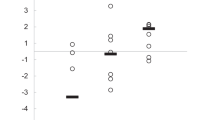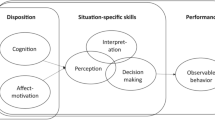Abstract
The original taxonomy of educational objectives, developed by Benjamin S.␣Bloom and his associates in the 1950s, was revised several decades later by a group of educationists and cognitive psychologists, who developed a revised taxonomy (RT). This article describes a Turkish study carried out among a group of pre-service teachers in order to compare the influence of the two systems on lesson planning skills. The results confirmed other studies that have indicated a number of advantages of the revised system over the earlier one.
Résumé
LES EFFETS DE LA TAXONOMIE RÉVISÉE DE BLOOM SUR LES TECHNIQUES DE PLANIFICATION DES LEÇONS – La taxonomie des objectifs Éducatifs, dÉveloppÉe à l’origine par Benjamin S. Bloom et ses associÉs dans les annÉes 50, a ÉtÉ remise à jour plusieurs dÉcennies plus tard par un groupe d’Éducateurs et de psychologues de la cognition ayant dÉveloppÉ une taxonomie rÉvisÉe (revised taxonomy: RT). Cet article dÉcrit une Étude turque effectuÉe parmi un groupe d’enseignants en formation afin de comparer l’influence des deux systèmes sur les techniques de planification de leÇons. Les rÉsultats ont confirmÉ d’autres Études ayant indiquÉ un certain nombre d’avantages du système rÉvisÉ par rapport à celui d’origine.
Zusammenfassung
DIE ANWENDUNG DER ÜBERARBEITETEN BLOOM’SCHEN TAXONOMIE AUF DIE UNTERRICHTSPLANUNG – Die ursprÜngliche Taxonomie fÜr Unterrichtszwecke, von Benjamin S. Bloom und Mitarbeitern in den 1950er Jahren entwickelt, wurde einige Jahrzehnte später durch eine Gruppe Erziehungswissenschaftler und kognitiver Psychologen Überarbeitet, die auch eine Neufassung erstellten (RT). Der Artikel stellt eine tÜrkische Studie Über die Fähigkeit zur Unterrichtsplanung von Lehramtsanwärtern dar, die zum Zweck des Vergleichs der beiden Systeme durchgefÜhrt wurde. Durch die Ergebnisse werden andere Studien bestätigt, die in der Neufassung der Taxonomie eine Reihe von Vorteilen gegenÜber der Ursprungsfassung erkennen.
Resumen
TAXONOMÍA DEL DOMINIO COGNITIVO, DE BLOOM; EFECTOS DE LA REVISIÓN – La taxonomÍa original de dominios del aprendizaje, desarrollada por S. Bloom y sus colegas en los años 50, fue revisada varias décadas después por un grupo de educadores y de psicÓlogos cognitivos, que desarrollaron una taxonomÍa revisada. Este artÍculo describe un estudio realizado en TurquÍa entre un grupo de docentes incipientes, a efectos de comparar la influencia de estos dos sistemas sobre la capacidad de planificar lecciones. El resultado confirmÓ los de otros estudios, que indicaban un número de ventajas del segundo sistema revisado frente al primero, el más antiguo.

Similar content being viewed by others
References
Airasian Peter W. 1996. Assessment in the Classroom. New York: McGraw Hill
Amer Aly 2006. Reflections on Bloom’s Revised Taxonomy. Electronic Journal of Research in Educational Psychology, 8(4), 213–230
Anderson Lorin W. 2002. Curricular Alignment: A Re-examination. Theory into Practice, 41(4), 255–260
Anderson, Lorin.W., and D. Krathwohl (eds.). 2001. A Taxonomy for Learning, Teaching, and Assessing: A Revision of Bloom’s Taxonomy of Educational Objectives. U.S.: Addison Wesley Longman, Inc
Athanassiou N., McNett J. M., Harvey C. 2003. Critical Thinking in the Management Classroom: Bloom’s Taxonomy as a Learning Tool. Journal of Management Education, 27(5), 533–555
Azizoğlu, H. 1989. Ankara Merkez Ilkokul Öğretmenlerinin Öğretim Planları Hakkındaki GÖrüşleri. [Opinions of the Central Ankara Classroom Teachers’ about the Instructional Planning] Unpublished Master’s Thesis, Hacettepe University, Ankara, Turkey
Bloom Benjamin S., Max D. Engelhart, E. J. Furst, W. H. Hill, D. R. Krathwohl 1956. Taxonomy of Educational Objectives, Handbook 1: The Cognitive Domain. New York: Longman
Bransford J., A. Brown, R. Cocking 1999. How People Learn: Brain, Mind, Experience, and School. Washington, DC: National Academy Press
Bümen Nilay T. 2006. The Evaluation of Doctoral Level “Development and Learning” and “Instructional Planning and Evaluation. Courses Theory into Practice: Educational Sciences, 6(1), 7–52
Byrd P. A. 2002. The Revised Taxonomy and Prospective Teachers. Theory into Practice, 41(4), 244–248
Carter R. 1985. A Taxonomy of Objectives for Professional Education. Studies in Higher Education, 10(2), 135–149
Creswell J. W. 2003. Research Design: Qualitative, Quantitative, and Mixed Method Approaches. USA: Sage Publications
Cohen J. 1988. Statistical Power Analysis for the Behavioral Sciences. Hillsdale, NJ: Erlbaum
English F., Steffy B. 2001. Deep Curriculum Alignment. Lanham, Maryland: Scarecrow
Ertürk, S. 1972. Eğitimde “Program” Geliştirme. [Curriculum Development in Education] Ankara: Meteksan A.ş
Ferguson C. 2002. Using the Revised Taxonomy to Plan and Deliver Team- Taught Integrated, Thematic Units. Theory into Practice, 41(4), 238–243
Flavell J. 1979. Metacognition and Cognitive Monitoring: A New Area of Cognitive-Developmental Inquiry. American Psychologist, 34, 906–911
Goodrich, Andrade H. 2001, April 17. The Effects of Instructional Rubrics on Learning to Write. Current Issues in Education [On-line] 4(4). Available: http://cie.ed.asu.edu/volume4/number4/
Goodwin, L. D. 2001. Interrater Agreement and Reliability. Measurement in Physical Education and Exercise Science, 5(1), 13–14
Gorin, J. and J. Blanchard. 2004, April. The Effect of Curriculum Alignment on Elementary Mathematics and Reading. Paper presented at the annual meeting of the American Educational Research Association, San Diego, CA
Kan, A. 2006. Ödev ve Projeler. In Atılgan, H. (ed). Eğitimde Ölçme ve Değerlendirme [Measurement and Evaluation in Education], 327–352. Ankara: Anı Yayıncılık
Krathwohl D. W. 2002. A Revision of Bloom’s Taxonomy: An Overwiew. Theory into Practice, 41(4): 212–218
Levy A., Z. Bathory 1994. The Taxonomy of Objectives in Continental Europe, Mediterranean, the Middle East. In Lorin W. Anderson, L.A. Sosniak (eds.), Bloom’s Taxonomy: A Forty-year Retrospective, pp 146–163. Chicago: University of Chicago Press
Mayer R. E. 2002. Rote versus Meaningful Learning. Theory into Practice, 41(4): 226–232
Ministry of National Education (MNE). 1998. İlköğretim Okulları Seçmeli Bilgisayar Dersi 1–5 öğretim Programı. [Elective Computer Lessons Curriculum for Grade 1–5] Tebliğler Dergisi 2492: 579–584
MNE. 2000. Lise Bilgisayar I Dersi Öğretim Programı. [Curriculum for High School Computer Lessons] Ankara: TTK
MNE. 2005. Eğitim Öğretim Çalışmalarının Planlı Yapılmasına Dair YÖnergede Değişiklik Yapılmasına Dair YÖnerge [A Directive about Modification for Instructional Planning] Tebliğler Dergisi 2575: 603
Morse J. M. 1991. Approaches to Qualitative – Quantitative Methodological Triangulation. Nursing Research, 40(1): 120–123
Moskal B. M. 2003. Recommendations for Developing Classroom Performance Assessment and Scoring Rubric. Practical Assessment, Research & Evaluation, 8: 14
Noble, T. 2004. Integrated the Revised Taxonomy with Multiple Intelligences: A Planning Tool for Curriculum Differentiation. Teachers College Record, 106(1): 193–211
Özçelik, D. A. 1989. Eğitim Programları ve Öğretim. [Curriculum and Instruction] Ankara: ÖSYM yayınları
Özçelik, D. A., Aksu, M., Berberoğlu, G., Paykoç, F. 1993. The Use of the Taxonomy of Educational Objectives in Turkey. Studies in Educational Evaluation, 19(1), 25–34
Pintrich, P. 2002. The role of Metacognitive Knowledge in Learning, Teaching, and Assessing. Theory into Practice, 41(4), 119–225
Pintrich P., C. Wolters, G. Baxter. 2000. Assessing Metacognition and Self-Regulated Learning. In: Issues in the Measurement of Metacognition (eds.), G. Schraw, J. Impara 43–97. Lincoln, NE: Buros Institude of Mental Measurements
Rohwer W. D. Jr., K. Sloane 1994. Psychological Perspectives. In: Lorin W. Anderson, L.A. Sosniak (eds.), Bloom’s Taxonomy: A Forty-year Retrospective, pp 41–63. Chicago: University of Chicago Press
Solman R., G. Rosen 1986. Blooms’s Six Cognitive Levels Represent Two Levels of Performance. Educational Psychology, 6(3), 243–263
Sönmez, V. 1985. Program Geliştirmede öğretmen Elkitabı. [A Handbook for Teachers in Curriculum Development] Ankara: PegemA yayıncılık
Strauss A. L., J. Corbin 1990. Basics of Qualitative Research: Grounded Theory Procedures and Techniques. Newbury Park, CA: Sage
Su W. M., P. J. Osisek, B. Starnes 2004. Applying the Revised Bloom’s Taxonomy to a Medical-surgical Nursing Lesson. Nurse Educator, 29(3), 116–120
Su W. M., P. J. Osisek, B. Starnes 2005. Using the Revised Bloom’s Taxonomy in the Clinical Laboratory Thinking Skills Involved in Diagnostic Reasoning. Nurse Educator, 30(3), 117–122
Thorndike R. L. 1990. Reliability. In: The International Encylopedia of Educational Evaluation, (eds.), Walberg J. H., Haertel D. G., 260–273.USA: Pergamon Press
Yıldırım, A., and K. Gündoğdu. 2004. Uzun Dönemli öğretim Planlarına Ilişkin öğretmen Algıları. [Teacher Perceptions of Long Term Instructional Plans] Education and Science 29(133): 11–19
Yıldırım, A., and E. Öztürk. 2002. Sınıf Öğretmenlerinin Günlük Planlarla Ilgili Algıları: Öncelikler, Sorunlar ve Öneriler. [Classroom Teacher Perceptions of Daily Instructional Plans: Priorities, Problems and Suggestions] İlkÖğretim Online 1(1): 17–27
Acknowledgements
Sincere thanks are extended to Professor Makbule - Alper Başbay, Eda Erdem, Bünyamin Yurdakul, and Hakan Atılgan for their contributions.
Author information
Authors and Affiliations
Corresponding author
Rights and permissions
About this article
Cite this article
Bümen, N.T. Effects of the Original Versus Revised Bloom's Taxonomy on Lesson Planning Skills: A Turkish Study Among Pre-Service Teachers. Int Rev Educ 53, 439–455 (2007). https://doi.org/10.1007/s11159-007-9052-1
Published:
Issue Date:
DOI: https://doi.org/10.1007/s11159-007-9052-1




